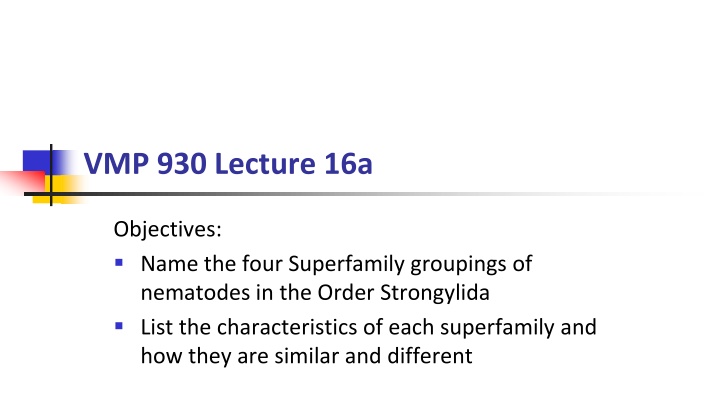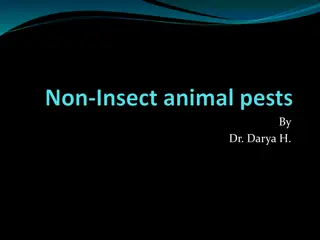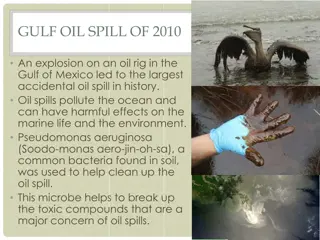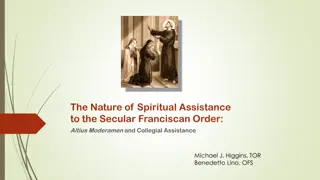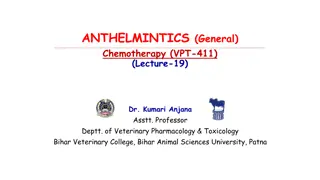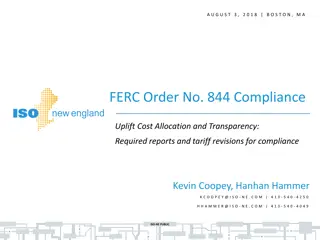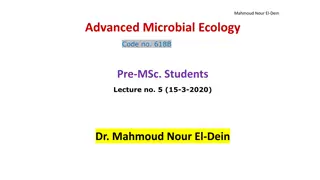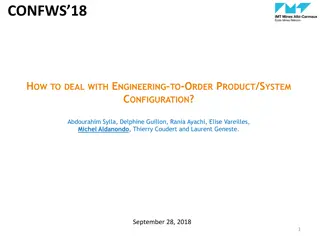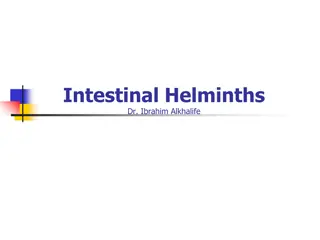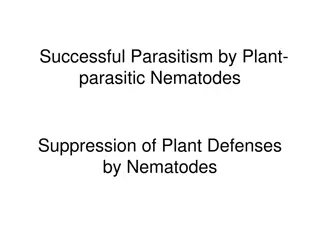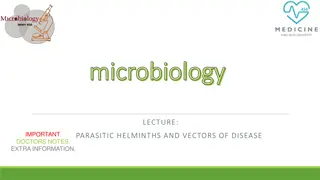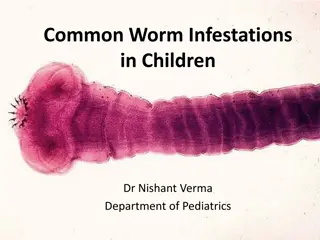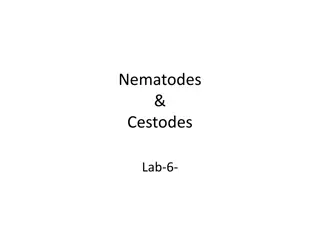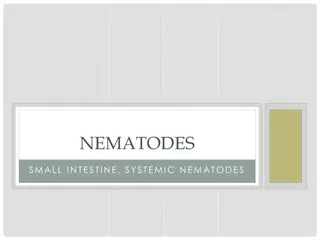Overview of Superfamilies in Order Strongylida Nematodes
The Order Strongylida in nematodes encompasses four main superfamilies - Trichostrongyloidea, Strongyloidea, Ancylostomoidea, and Metastrongyloidea. Each superfamily is defined by distinct characteristics such as buccal cavity size and location within the host, as well as differences in life cycle and routes of infection. Trichostrongyloidea and Strongyloidea primarily infect ruminants and equids, respectively, through ingestion of herbage while grazing, while Ancylostomoidea includes hookworms with toothed buccal capsules. Metastrongyloidea, on the other hand, lacks a buccal cavity and requires intermediate hosts like mollusks or annelids. Understanding these superfamilies is essential for the management and control of nematode infections in animals.
Download Presentation

Please find below an Image/Link to download the presentation.
The content on the website is provided AS IS for your information and personal use only. It may not be sold, licensed, or shared on other websites without obtaining consent from the author.If you encounter any issues during the download, it is possible that the publisher has removed the file from their server.
You are allowed to download the files provided on this website for personal or commercial use, subject to the condition that they are used lawfully. All files are the property of their respective owners.
The content on the website is provided AS IS for your information and personal use only. It may not be sold, licensed, or shared on other websites without obtaining consent from the author.
E N D
Presentation Transcript
VMP 930 Lecture 16a Objectives: Name the four Superfamily groupings of nematodes in the Order Strongylida List the characteristics of each superfamily and how they are similar and different
Order Strongylida - general morphology Bursate worms : males have a distinctive copulatory bursa. Lobes (braket) supported by rays (arrow). lobe ray
Order Strongylida - general morphology Buccal area (mouth): used to subdivide these worms into 4 superfamilies. 1. Trichostrongyloidea - very small buccal cavity, in ruminant abomasum or small intestine Buccal cavity
Order Strongylida - general morphology (cont.) 2. Strongyloidea - very large buccal cavity with leaf crown on buccal capsule, in equid large intestine. Host mucosa Buccal capsule
Order Strongylida - general morphology (cont.) 3. Ancylostomoidea (hookworms) - buccal cavity is bent dorsally, buccal capsule has teeth or cutting plates at anterior opening. teeth Axis of worm body
Order Strongylida - general morphology (cont.) 4. Metastrongyloidea - lacks buccal cavity, worms found in lungs or nervous system.
Order Strongylida - general life cycles Three superfamilies have free-living larval forms that must develop to infective L3 in the environment outside of the host. Most produce strongyle type eggs (aka ova), with exceptions of those that develop larvae before passed in feces. Metastrongyloidea superfamily is the exception in that its genera require mollusk or annelid intermediate hosts.
Order Strongylida - general life cycles (cont.) Routes of infection: 1. Ingestion with herbage while grazing is the only significant route for Trichostrongyloidea (trichostrongyles) in ruminants and Strongyloidea (strongyles) in horses.
Route of Infection Trichostrongyles and Strongyles 3 1 deadly dew-drop 2
Order Strongylida - general life cycles (cont.) Routes of infection (cont.): 2. Skin penetration and ingestion, including lactogenic, is used by Ancylostomoidea (hookworm). Cutaneous larval migrans lesion from infective larva
Order Strongylida - general life cycles (cont.) Routes of infection (cont.): 3. Ingestion of infected intermediate host is used by Metastrongyloidea genera. Slug (or snail) containing L3 Earthworm containing L3
Discussion Question How many superfamilies of nematodes have genera that produce eggs with the same strongyle-type morphology? What is required to get this type of egg to develop to an infective stage?
VMP 930 lecture 16b Objectives: Compare cattle with small ruminants regarding trichostrongyle nematode infection and disease. Know the host location and adult worm morphology of Trichostrongylusaxei, Ostertgiaostertagi, Haemonchus contortus, and Cooperia.
Superfamily Trichostrongyloidea commonly called trichostrongyles Haemonchus, Ostertagia, Trichostrongylus (HOT) plus Cooperia are the genera that infect the abomasum and duodenum of grazing ruminants. Sheep and goats are most severely affected by Haemonchus contortus. Cattle are most severely affected by Ostertagia ostertagi.
Trichostrongylus spp. Trichostrongylus axei - found in the abomasum of ruminants and stomach of horses. Trichostrongylus colubriformis - found in the small intestine of ruminants. Both Trichostrongylus sp. also infect rabbit, pig and man (be careful where you graze).
Trichostrongylus axei Trichostrongylus axei. - Adults are less than 7 mm long. spicules T. axei adult male Copulatory bursa
Trichostrongylus axei Rarely causes clinical disease alone. Exception: horses can develop clinical disease. Catarrhal gastritis Risk of being pastured with sheep. Nodular hyperplasia
Ostertagia spp. Ostertagia ostertagi - most important helminth parasite of cattle. Teladorsagia (O.) circumcincta - infects sheep, goats and llamas. Host species specific. Does not cross infect. Common name - brown stomach worm.
Ostertagia sp. Adult worms are 7 to 14 mm long, brown in color. Fecal egg counts above 200 indicate high worm burden. Adult worms on gastric mucosa. Note bubbles due to protein loss into lumen. adult male copulatory bursa & spicules
Ostertagia sp. emerging, metabolically active L4 Ostertagia sp. pathogenesis: 1. L3 ingested from pasture enter the gastric glands and develop to L4 then emerge to gastric lumen or are hypobiotic in glands. Prepatent time is 3 weeks. hypobiotic, arrested L4
Ostertagia sp. Ostertagia sp. pathogenesis (cont.): 2. Cells lining gland dedifferentiate, stop producing acid. Abomasal pH increases. 3. Mucosal cells at entrance of gland proliferate, small nodules = moroccan leather appearance of mucosal surface. nodules of proliferating gastric mucosal cells
Ostertagia sp. Ostertagia sp. pathogenesis (cont.): 4. Leaky mucosa causes loss of protein and fluid to abomasal lumen. 5. Systemically there is increased protein catabolism and nitrogen excretion in urine. 6. Hypoproteinemia.
Ostertagia sp. Ostertagia clinical signs: 1. Anorexia - loss of appetite. calves showing no interest in grazing
Ostertagia sp. 2. Diarrhea - watery diarrhea in calves. 3. Edema due to protein loss. intramandibular edema
Ostertagia sp. infected, unlimited feed uninfected, feed equal to infected intake uninfected, unlimited feed 4. Decreased weight gain, poor growth due to anorexia and protein catabolism. 5. Subclinical effects revealed by anthelmintic therapy. proximal tibia showing haversian canal growth activity
Ostertagia sp. Ostertagia in cattle causes clinical signs in young, growing calves. Due to age resistance mature cows seldom show clinical disease.
Haemonchus sp. Haemonchus contortus: most important helminth parasite of sheep and goats. Reports of H. contortus infecting cattle, but not as pathogenic as in sheep. Haemonchus placei: species specific for cattle. Common name = barber pole worm.
Haemonchus sp. Found in the abomasum Adult female showing barber pole affect adults up to 30 mm long, blood-filled worm gut and twisted reproductive tract gives red & white barber pole affect. Fecal egg counts above 1000 indicate high worm burden. Adult male copulatory bursa
Haemonchus sp. Haemonchus pathogenesis: prepatent (3 weeks) adult worms in lumen of abomasum blood feeders loss of blood leading to anemia and hypoproteinemia can be severe within one week of ingestion of large number of infective larvae. adult worm showing blood-filled digestive tract
Haemonchus sp. Clinical Signs edema of lips intramandibular edema pale conjunctiva, FAMACHA score? black tarry feces, not diarrhea
Haemonchus sp. Clinical signs: Signs of blood loss, anemia pale mucous membranes, low hematocrit, rapid shallow breathing and high heart rate, prostrate. Body condition may be good in acute infections. Black, tarry feces. Not diarrhea. Edema of lips, intramandibular region, limbs.
Other trichostrongyles adult stage, anterior end Cooperia and Nematodirus are trichostrongyles that infect the proximal small intestine of ruminants. Cooperia drug resistance is a growing concern in cattle. Nematodirus ova strongyle-type ova
Other trichostrongyles As with Trichostrongylus, they are important as mixed infections with Ostertagia or Haemonchus.
Discussion Question Describe a scenario for the occurrence of clinical disease from Haemonchus infection in sheep. Describe a scenario for the occurrence of clinical disease from Ostertagia infection in cattle.
